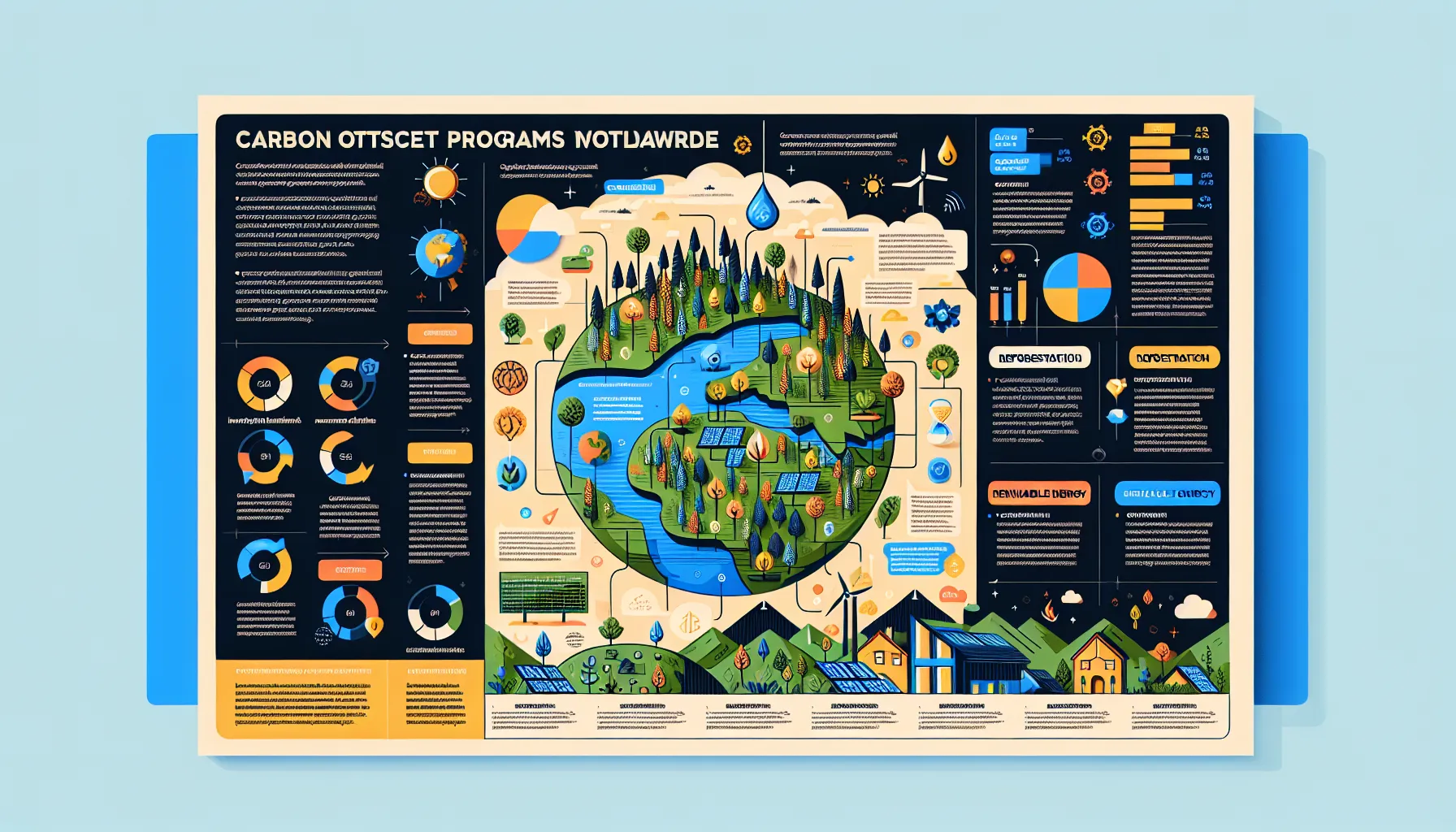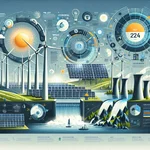In this IELTS Reading practice test, we’ll explore the fascinating topic of “Carbon offset programs in 2024.” This subject is not only relevant to current environmental discussions but also provides an excellent opportunity to enhance your reading comprehension skills for the IELTS exam. Let’s dive into three passages of increasing difficulty, followed by a variety of question types to test your understanding and prepare you for success in the IELTS Reading section.
 Carbon offset programs in 2024
Carbon offset programs in 2024
Passage 1 (Easy Text)
The Basics of Carbon Offset Programs
Carbon offset programs have gained significant traction in recent years as a means to mitigate the impact of greenhouse gas emissions. In 2024, these initiatives have evolved to become more sophisticated and diverse than ever before. At their core, carbon offset programs aim to compensate for carbon dioxide emissions in one area by reducing or removing emissions elsewhere.
One of the most popular forms of carbon offsetting involves reforestation projects. By planting trees, these programs help absorb carbon dioxide from the atmosphere, effectively creating natural carbon sinks. In 2024, advanced monitoring technologies, such as satellite imaging and drone surveillance, are being employed to ensure the success and longevity of these reforestation efforts.
Another prevalent type of carbon offset program focuses on renewable energy initiatives. These projects invest in the development and implementation of clean energy sources like solar, wind, and hydroelectric power. By replacing fossil fuel-based energy production with renewable alternatives, these programs contribute to a significant reduction in carbon emissions.
Carbon offset programs in 2024 also include innovative approaches such as methane capture from landfills and agricultural waste. These initiatives not only prevent potent greenhouse gases from entering the atmosphere but also often generate usable energy in the process.
As public awareness of climate change continues to grow, many individuals and businesses are choosing to participate in carbon offset programs. This increased demand has led to the development of user-friendly platforms that allow people to easily calculate their carbon footprint and purchase offsets to neutralize their impact.
While carbon offset programs are not a panacea for climate change, they represent an important tool in the global effort to reduce greenhouse gas emissions and mitigate the impacts of human activity on the environment.
Questions 1-7
Do the following statements agree with the information given in the reading passage?
Write:
TRUE if the statement agrees with the information
FALSE if the statement contradicts the information
NOT GIVEN if there is no information on this
- Carbon offset programs have become more complex and varied in 2024.
- Reforestation projects are the only type of carbon offset program available.
- Advanced technologies are used to monitor the progress of reforestation efforts.
- Renewable energy initiatives focus exclusively on solar power.
- Methane capture programs can generate usable energy.
- Public participation in carbon offset programs has decreased in recent years.
- Carbon offset programs are considered the ultimate solution to climate change.
Questions 8-10
Complete the sentences below.
Choose NO MORE THAN TWO WORDS from the passage for each answer.
- Carbon offset programs aim to __ for carbon dioxide emissions in one area by reducing emissions elsewhere.
- __ and drone surveillance are used to monitor reforestation projects.
- Many individuals and businesses use __ platforms to calculate their carbon footprint and purchase offsets.
Passage 2 (Medium Text)
The Evolution and Challenges of Carbon Offset Programs in 2024
As we progress through 2024, carbon offset programs have undergone significant transformations, adapting to the ever-evolving landscape of climate change mitigation. These programs, which allow individuals and organizations to invest in environmental projects to balance out their own carbon footprints, have become increasingly sophisticated. However, they also face new challenges in a world grappling with the escalating impacts of global warming.
One of the most notable developments in carbon offset programs is the integration of blockchain technology. This innovation has revolutionized the way carbon credits are tracked and traded, providing unprecedented transparency and reducing the risk of double-counting or fraud. Blockchain-based platforms enable real-time monitoring of offset projects, ensuring that the promised carbon reductions are actually achieved and verified.
Another significant trend is the shift towards community-based offset projects. These initiatives not only focus on reducing carbon emissions but also aim to provide tangible benefits to local communities. For example, a program might combine reforestation efforts with sustainable agriculture training for local farmers, creating a symbiotic relationship between environmental conservation and economic development.
The rise of artificial intelligence (AI) in carbon offset programs has also been remarkable. AI algorithms are now being used to optimize the selection and management of offset projects, ensuring maximum impact for every dollar invested. These systems can analyze vast amounts of data to predict the long-term effectiveness of different offset strategies and adjust allocations accordingly.
Despite these advancements, carbon offset programs in 2024 face several challenges. One of the most pressing issues is the saturation of traditional offset markets. As more companies and individuals seek to offset their emissions, the demand for high-quality offset projects has begun to outstrip supply in some areas. This has led to concerns about the additionality of some projects – whether they truly represent emissions reductions that wouldn’t have happened otherwise.
Another challenge is the increasing scrutiny from regulators and environmental groups. As carbon offset programs play a larger role in climate strategies, there is growing pressure to ensure their effectiveness and legitimacy. This has led to the development of more stringent verification processes and standards, which, while necessary, can increase the complexity and cost of implementing offset programs.
Climate change itself poses a risk to certain types of offset projects. For instance, reforestation efforts may be jeopardized by increased wildfires or changing precipitation patterns. This has prompted a reevaluation of risk assessment models for offset projects and a greater emphasis on diversification strategies.
Looking ahead, the future of carbon offset programs in 2024 and beyond will likely involve a continued focus on innovation and adaptation. As our understanding of climate science evolves and new technologies emerge, these programs will need to remain flexible and responsive to ensure they continue to make a meaningful contribution to global emissions reduction efforts.
Questions 11-15
Choose the correct letter, A, B, C, or D.
-
According to the passage, blockchain technology in carbon offset programs:
A) Has made carbon credits more expensive
B) Has increased the risk of fraud
C) Has improved transparency and tracking
D) Has slowed down the trading of carbon credits -
Community-based offset projects aim to:
A) Focus solely on reducing carbon emissions
B) Provide benefits to local communities alongside environmental goals
C) Replace traditional reforestation efforts
D) Decrease economic development in favor of conservation -
The role of artificial intelligence in carbon offset programs includes:
A) Replacing human decision-making entirely
B) Optimizing project selection and management
C) Increasing the cost of offset programs
D) Slowing down the implementation of projects -
One of the challenges faced by carbon offset programs in 2024 is:
A) Lack of interest from companies and individuals
B) Oversupply of high-quality offset projects
C) Saturation of traditional offset markets
D) Decreased scrutiny from regulators -
The passage suggests that the future of carbon offset programs will involve:
A) Abandoning current strategies completely
B) Focusing solely on reforestation efforts
C) Ignoring technological advancements
D) Continued innovation and adaptation
Questions 16-20
Complete the summary below.
Choose NO MORE THAN TWO WORDS from the passage for each answer.
Carbon offset programs in 2024 have evolved significantly, incorporating new technologies and approaches. The use of (16) __ has improved the tracking and trading of carbon credits. There’s also a trend towards (17) __ offset projects that benefit local economies. (18) __ is being used to optimize project selection and management. However, these programs face challenges such as market saturation and increased (19) __ from regulators. Climate change itself poses risks to some projects, leading to a greater emphasis on (20) __ strategies.
Passage 3 (Hard Text)
The Paradigm Shift in Carbon Offset Programs: Innovations and Implications for 2024 and Beyond
The landscape of carbon offset programs in 2024 has undergone a paradigm shift, characterized by unprecedented technological integration, heightened scrutiny, and a reevaluation of traditional methodologies. This transformation is not merely an evolution of existing practices but a fundamental reimagining of how carbon offsetting can effectively contribute to global climate change mitigation efforts.
One of the most salient developments is the emergence of quantum computing in carbon offset verification and optimization. Quantum algorithms have demonstrated the capacity to model complex environmental systems with a degree of accuracy previously thought unattainable. This quantum leap in computational power allows for real-time analysis of carbon sequestration rates, taking into account myriad variables such as soil composition, atmospheric conditions, and even microbial activity. The ramifications of this advancement are profound, enabling a level of precision in carbon accounting that significantly enhances the credibility and efficacy of offset programs.
Concurrently, the integration of Internet of Things (IoT) devices has revolutionized data collection for offset projects. A vast network of sensors, deployed across diverse ecosystems, continuously transmits data on carbon flux, biodiversity metrics, and other key environmental indicators. This ubiquitous monitoring capability not only ensures the integrity of offset projects but also provides invaluable data for climate research. The synergy between IoT devices and quantum computing creates a powerful feedback loop, constantly refining predictive models and optimization strategies.
The year 2024 has also witnessed the rise of bioengineered carbon sinks. Leveraging advances in synthetic biology, scientists have developed genetically modified organisms (GMOs) with enhanced carbon sequestration capabilities. These range from algal blooms engineered to absorb carbon dioxide at rates far exceeding their natural counterparts to modified tree species with augmented lignin production for long-term carbon storage. While promising, these bioengineered solutions have sparked intense debate regarding their potential ecological impacts and the ethics of releasing GMOs into natural environments.
In the realm of policy and governance, the establishment of the Global Carbon Offset Regulatory Framework (GCORF) in 2024 marks a significant milestone. This international body sets stringent standards for offset verification, introduces a universal carbon credit currency, and implements a blockchain-based ledger for transparent tracking of all offset transactions. The GCORF’s mandate also includes addressing the issue of carbon leakage – where emissions reduction in one area leads to increased emissions elsewhere – through comprehensive life cycle assessments of offset projects.
Artificial Intelligence (AI) has transcended its role as a mere analytical tool and now functions as an autonomous agent in carbon offset markets. AI-driven platforms not only match offset providers with buyers but also dynamically adjust pricing based on real-time assessments of project efficacy and global carbon reduction goals. These systems employ predictive analytics to forecast the long-term impact of offset projects, factoring in potential risks such as political instability, climate change-induced disasters, and shifts in land use patterns.
The concept of carbon insetting has gained significant traction in 2024, particularly among multinational corporations. Unlike traditional offsetting, which often involves investing in external projects, insetting focuses on integrating carbon reduction initiatives directly into a company’s supply chain and operations. This approach not only reduces emissions but also enhances supply chain resilience and often yields co-benefits such as improved community relations and ecosystem services.
Despite these advancements, the carbon offset landscape in 2024 is not without its detractors. Critics argue that the increasing complexity and technological dependence of offset programs may exacerbate existing inequalities, potentially marginalizing smaller, community-based projects that lack access to cutting-edge technologies. There are also concerns about the over-reliance on technological solutions, potentially diverting attention and resources from fundamental changes in consumption patterns and energy systems necessary for true sustainability.
As we look beyond 2024, the future of carbon offset programs appears to be at a critical juncture. The integration of advanced technologies offers unprecedented opportunities for accuracy, efficiency, and scale. However, the challenge lies in balancing these technological capabilities with ethical considerations, equitable access, and the fundamental need for systemic change in how societies interact with the environment. The success of carbon offset programs in the coming years will largely depend on their ability to navigate these complex interplays, ensuring that they remain a viable and integral part of the global strategy to combat climate change.
Questions 21-26
Complete the summary below.
Choose NO MORE THAN TWO WORDS from the passage for each answer.
Carbon offset programs in 2024 have undergone a significant transformation, incorporating advanced technologies and new methodologies. (21) __ has revolutionized carbon offset verification, allowing for extremely accurate modeling of environmental systems. The use of (22) __ devices has improved data collection across various ecosystems. Scientists have developed (23) __ with enhanced carbon absorption capabilities, although these have sparked debates about their potential impacts. The establishment of the (24) __ has set new standards for offset verification and introduced a universal carbon credit currency. AI now functions as an (25) __ in carbon offset markets, dynamically adjusting pricing and assessing project efficacy. However, critics argue that the increasing complexity of these programs may (26) __ existing inequalities.
Questions 27-33
Do the following statements agree with the claims of the writer in the reading passage?
Write:
YES if the statement agrees with the claims of the writer
NO if the statement contradicts the claims of the writer
NOT GIVEN if it is impossible to say what the writer thinks about this
- Quantum computing has made it possible to analyze carbon sequestration rates with unprecedented accuracy.
- The integration of IoT devices in offset projects has reduced the need for human oversight.
- Bioengineered carbon sinks are universally accepted as a solution to enhance carbon sequestration.
- The Global Carbon Offset Regulatory Framework addresses the issue of carbon leakage through life cycle assessments.
- AI-driven platforms in carbon offset markets are limited to matching buyers with sellers.
- Carbon insetting is primarily focused on external offset projects for multinational corporations.
- The future success of carbon offset programs depends on balancing technological advancements with ethical and equitable considerations.
Questions 34-40
Complete the sentences below.
Choose NO MORE THAN TWO WORDS from the passage for each answer.
- The integration of quantum computing in carbon offset programs is described as a __ in computational power.
- IoT devices and quantum computing create a __ that constantly refines predictive models.
- Genetically modified organisms developed for carbon sequestration include algal blooms and trees with increased __ production.
- The GCORF has implemented a __ for transparent tracking of all offset transactions.
- AI systems in carbon offset markets use __ to forecast the long-term impact of projects.
- Carbon insetting focuses on integrating carbon reduction initiatives into a company’s __ and operations.
- Critics argue that the complexity of modern offset programs may marginalize __ projects lacking access to advanced technologies.
Answer Key
Passage 1 (Easy Text)
- TRUE
- FALSE
- TRUE
- FALSE
- TRUE
- FALSE
- FALSE
- compensate
- Satellite imaging
- user-friendly
Passage 2 (Medium Text)
- C
- B
- B
- C
- D
- blockchain technology
- community-based
- Artificial intelligence
- scrutiny
- diversification
Passage 3 (Hard Text)
- Quantum computing
- Internet of Things
- bioengineered carbon sinks
- Global Carbon Offset Regulatory Framework
- autonomous agent
- exacerbate
- YES
- NOT GIVEN
- NO
- YES
- NO
- NO
- YES
- quantum leap
- powerful feedback loop
- lignin
- blockchain-based ledger
- predictive analytics
- supply chain
- community-based
By practicing with this comprehensive IELTS Reading test on Carbon Offset Programs in 2024, you’ve not only enhanced your understanding of this crucial environmental topic but also honed your skills in various question types typically found in the IELTS exam. Remember to review carbon footprint reduction strategies to deepen your knowledge on related environmental issues. Additionally, exploring the impact of AI on reducing carbon emissions can provide valuable insights into the intersection of technology and environmental conservation. Keep practicing with diverse topics and question formats to improve your IELTS Reading performance!


